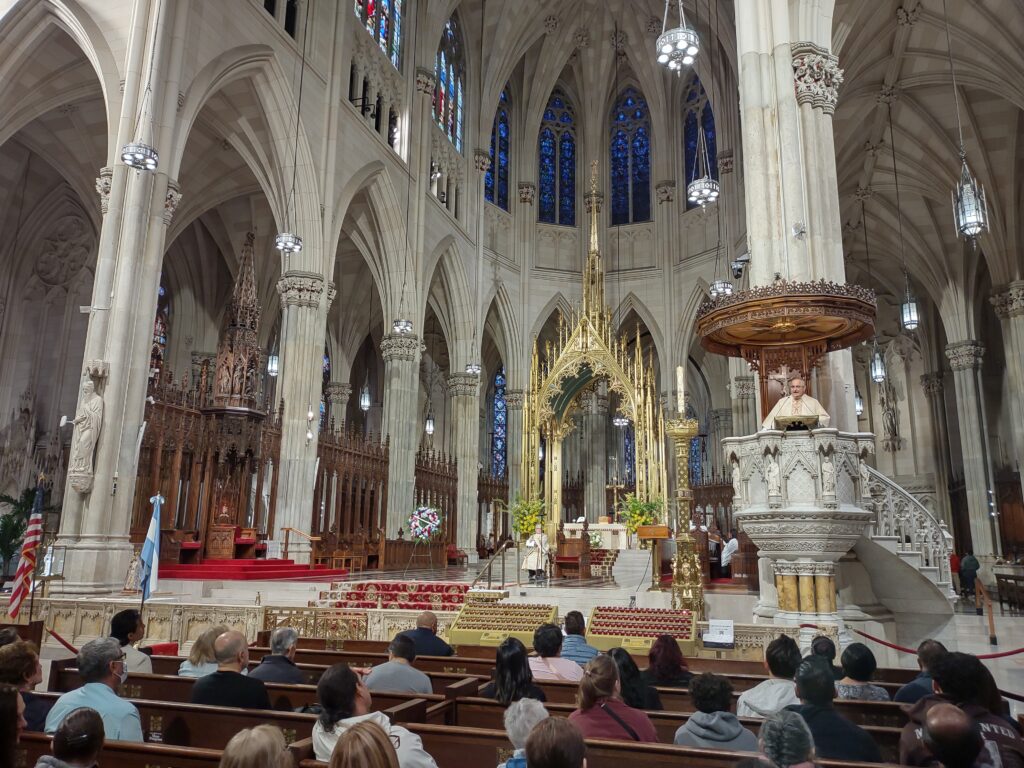
Our Lady of Lujan Mass (Argentina) Celebrated at St. Patrick’s Cathedral
By: Armando Machado
“The Virgin of Lujan for us is not just a symbol of faith – she is a companion inseparable from our identity as a nation”

Father Pablo Ruani, parochial vicar at the Church of St. Leo the Great in Corona, Queens, served as principal celebrant and homilist of the annual Our Lady of Lujan Mass at St. Patrick’s Cathedral. Our Lady of Lujan is the patroness of Argentina.
St. Leo the Great Church is part of the Diocese of Brooklyn. Father Ruani was born and raised in Argentina and ordained there in 1992.
“Dear brothers sisters in Christ Jesus, on this sixth Sunday of Easter, we gather here at St. Patrick’s Cathedral for a very special reason that adds to the Easter of the community of Argentinians who are present here, and to all who are present to honor their Mother, the Mother of the Church,” Father Ruani said early on in the homily. “She is the Mother of God and our beloved patroness – Argentinians, Uruguayans and Paraguayans, we have a profound pride in being able to call her Our Mother, the Virgin of Lujan.”
The Spanish Mass was held on Sunday, May 25. About 1,000 people attended.
“The Church is one – and it is diverse,” Father Ruani continued during his homily message. “The Virgin of Lujan for us is not just a symbol of faith – she is a companion inseparable from our identity as a nation, from the dawn of our history, from when she made herself present in 1630…as a small, humble image, of which we have a replica here…It is a reality of our culture.” (The replica — a copy of a small statue of Our Lady of Lujan that has been venerated in Argentina since 1630 — was on display at the sanctuary steps after having been featured in the entrance procession.)
Father Ruani said the Lord God loves us and gave us a Redeemer, the Lord Jesus, and for this, “we should thank Him every day.” The priest spoke of the importance of doing good deeds based on the Lord’s Word and of praying for governmental leaders so that they may govern “with wisdom, prudence, and justice.”
He noted that the feast day of Our Lady of Lujan is May 8, the same date that Leo XIV was elected pope. He said the founding leaders of Argentina, “with courage and faith,” were guided by their devotion to Our Lady of Lujan. Father Ruani then noted that the date of the Our Lady of Lujan Mass, May 25, is also significant in Argentina’s history:
The South American nation was founded in 1816 when it gained independence from Spain. On May 25, 1810, in Buenos Aires, the city-state of Buenos Aires in the Viceroyalty of the Río de la Plata, the May Revolution culminated in the formation of the Primera Junta, the first independent government of Argentina. This event, which replaced the Viceroy, Baltasar Hidalgo de Cisneros, with a local junta, marked a key step towards Argentina’s eventual independence.
On May 27, Father Ruani told The Good Newsroom by phone, “I was honored to be invited to celebrate the Mass. It was very special, emotional.” The priest said he has triple citizenship: Argentina, the United States, and Italy.
Story of Our Lady of Lujan
The figure of Our Lady of Lujan is a small statue that has been venerated in Argentina since 1630. According to tradition, in 1630, a rancher, a member of a caravan, was taking the Marian figure from Buenos Aires to his ranch in Santiago del Estero. But the oxen pulling the wagon stopped inexplicably by the Lujan River.
The oxen didn’t move again until the statue was taken out of the wagon, despite the unloading of all other items from the wagon. After repeating this action and realizing the oxen would not move while the statue was in the wagon, the caravan members concluded that this was a sign that Blessed Mother Mary wanted the statue to stay in Lujan.
In 1887, the figure was crowned canonically and was moved to its current sanctuary, which was given the title of basilica in 1930 by Pope Pius XII. The feast day of Our Lady of Lujan is May 8. St. John Paul II visited the basilica as pope in 1982, and on May 8, 2013, Pope Francis (who is originally from Argentina) visited the Basilica of Lujan to commend Argentina to the protection of its patroness.

